A slice of a pallasite meteorite fragment
of what was once a meteoroid before it collided with Earth, discovered
in Argentina; on display at the Museum of Nature, Ottawa, Canada.
The visible streak of light from space debris is the result of heat as it enters a planet's atmosphere, and the glowing particles that it sheds in its wake is called a meteor, or colloquially a "shooting star" or "falling star". Many meteors appearing seconds or minutes apart, and appearing to originate from the same fixed point in the sky, are called a meteor shower. The root word meteor comes from the Greek meteōros, meaning "suspended in the air". Objects larger than several meters can explode in the air and create damage. If a meteoroid, comet or asteroid withstands ablation from its atmospheric entry and impacts with the ground, then it is called a meteorite.
Around 15,000 tonnes of meteoroids, micrometeoroids and different forms of space dust enter Earth's atmosphere each year.[7]
Meteoroids
See also: Micrometeoroid
Meteoroid composition
The composition of meteoroids can be inferred as they pass through Earth's atmosphere from their trajectories and the light spectra of the resulting meteor. Their effects on radio signals also give information, especially useful for daytime meteors which are otherwise very difficult to observe. From these trajectory measurements, meteoroids have been found to have many different orbits, some clustering in streams (see Meteor showers) often associated with a parent comet, others apparently sporadic. Debris from meteoroid streams may eventually be scattered into other orbits. The light spectra, combined with trajectory and light curve measurements, have yielded various compositions and densities, ranging from fragile snowball-like objects with density about a quarter that of ice,[13] to nickel-iron rich dense rocks. The study of meteorites also gives insights into the composition of non-ephemeral meteoroids.Meteoroids in the Solar System
Meteoroids travel around the Sun in a variety of orbits and at various velocities. The fastest ones move at about 42 kilometers per second through space in the vicinity of Earth's orbit.[citation needed] The Earth travels at about 29.6 kilometers per second. Thus, when meteoroids meet Earth's atmosphere head-on (which only occurs when meteors are in a retrograde orbit such as the Eta Aquarids, which are associated with the retrograde Halley's Comet), the combined speed may reach about 71 kilometers per second. Meteoroids moving through Earth's orbital space average about 20 km/s.[14]On 2013 January 17 at 5:21 PST a 1 meter-sized meteoroid/comet from the Oort cloud impacted Earth.[15] The meteoroid had a retrograde orbit with perihelion at 0.98 ± 0.03 AU. It approached from the direction of the constellation Virgo, and collided head-on with Earth going 72 ± 6 km/s.[15]
Meteoroid collisions with Earth and its atmosphere
When meteoroids intersect with the Earth's atmosphere at night, they are likely to become visible as meteors. If meteoroids survive the entry through the atmosphere and reach the Earth's surface, they are called meteorites. Meteorites are transformed in structure and chemistry by the heat of entry and force of impact. A noted meteoroid, 2008 TC3, was observed in space on a collision course with Earth on 6 October 2008 and entered the Earth's atmosphere the next day, striking a remote area of northern Sudan. It was the first time that a meteoroid had been observed in space and tracked prior to impacting Earth.Meteor
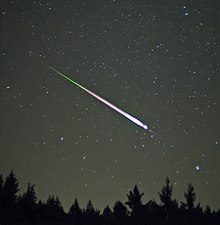
A Leonid meteor, seen in the 2009 Leonid Meteor Shower.
- "Meteor" and "Meteors" redirect here. For other uses, see Meteor (disambiguation).

Photo of a part of the sky during a meteor shower over an extended exposure time. The meteors have actually occurred several seconds to several minutes apart.
See also: List of meteor air bursts
A meteor or "shooting star" is the visible streak of light from a meteoroid or micrometeoroid,
heated and glowing from entering the Earth's atmosphere, as it sheds
glowing material in its wake. Meteors typically occur in the mesosphere at altitudes between 76 km to 100 km (46–62 miles).[16] Millions of meteors occur in the Earth's atmosphere daily. Most meteoroids that cause meteors are about the size of a pebble. Meteors may occur in showers,
which arise when the Earth passes through a stream of debris left by a
comet, or as "random" or "sporadic" meteors, not associated with a
specific stream of space debris. A number of specific meteors have been
observed, largely by members of the public and largely by accident, but
with enough detail that orbits of the meteoroids producing the meteors
have been calculated. All of the orbits passed through the asteroid belt.[17] The atmospheric velocities of meteors result from the movement of Earth around the Sun at about 30 km/s (18 miles/second),[18] the orbital speeds of meteoroids, and the gravity well of Earth.Meteors become visible between about 75 to 120 km (34–70 miles) above the Earth. They disintegrate at altitudes of 50 to 95 km (31–51 miles).[citation needed] Meteors have roughly a fifty percent chance of a daylight (or near daylight) collision with the Earth. Most meteors are, however, observed at night, when darkness allows fainter objects to be recognized. For bodies with a size scale larger than (10 cm to several metres) meteor visibility is due to the atmospheric ram pressure (not friction) that heats the meteoroid so that it glows and creates a shining trail of gases and melted meteoroid particles. The gases include vaporized meteoroid material and atmospheric gases that heat up when the meteoroid passes through the atmosphere. Most meteors glow for about a second. A relatively small percentage of meteoroids hit the Earth's atmosphere and then pass out again: these are termed Earth-grazing fireballs (for example The Great Daylight 1972 Fireball). The visible light produced by a meteor may take on various hues, depending on the chemical composition of the meteoroid, and the speed of its movement through the atmosphere. As layers of the meteoroid abrade and ionize, the color of the light emitted may change according to the layering of minerals. Possible colors (and elements producing them) include:
- Orange/yellow (sodium)
- Yellow (iron)
- Blue/green (copper)
- Purple (potassium)
- Red (silicate)
Fireball
See also: List of meteor air bursts
A 'fireball' is a brighter-than-usual meteor. The International Astronomical Union defines a fireball as "a meteor brighter than any of the planets" (magnitude −4 or greater).[19] The International Meteor Organization
(an amateur organization that studies meteors) has a more rigid
definition. It defines a fireball as a meteor that would have a
magnitude of −3 or brighter if seen at zenith.
This definition corrects for the greater distance between an observer
and a meteor near the horizon. For example, a meteor of magnitude −1 at 5
degrees above the horizon would be classified as a fireball because if
the observer had been directly below the meteor it would have appeared
as magnitude −6.[20] For 2011 there are 4589 fireballs records at the American Meteor Society.[21] Fireballs reaching magnitude −14 or brighter are called bolides.[22]
The IAU has no official definition of "bolide", and generally considers
the term synonymous with "fireball". Astronomers often use "bolide" to
identify an exceptionally bright fireball, particularly one that
explodes (sometimes called a detonating fireball). It may also be used
to mean a fireball which creates audible sounds. In the late twentieth
century, bolide has also come to mean any object that hits the Earth and
explodes, with no regard to its composition (asteroid or comet).[23] The word bolide comes from the Greek βολίς (bolis) [24] which can mean a missile or to flash. If the magnitude of a bolide reaches −17 or brighter it is known as a superbolide.[22][25]Atmospheric remains of meteor passage
Entry of meteoroids into the Earth's atmosphere produces three main effects: ionization of atmospheric molecules, dust that the meteoroid sheds, and the sound of passage.During the entry of a meteoroid or asteroid into the upper atmosphere, an ionization trail is created, where the molecules in the upper atmosphere are ionized by the passage of the meteor. Such ionization trails can last up to 45 minutes at a time. Small, sand-grain sized meteoroids are entering the atmosphere constantly, essentially every few seconds in any given region of the atmosphere, and thus ionization trails can be found in the upper atmosphere more or less continuously. When radio waves are bounced off these trails, it is called meteor burst communications. Meteor radars can measure atmospheric density and winds by measuring the decay rate and Doppler shift of a meteor trail. Most meteoroids burn up when they enter the atmosphere. The left-over debris is called meteoric dust or just meteor dust. Meteor dust particles can persist in the atmosphere for up to several months. These particles might affect climate, both by scattering electromagnetic radiation and by catalyzing chemical reactions in the upper atmosphere.[26] Larger meteors can enter dark flight after deceleration where the meteorite (or fragments) fall at terminal velocity.[27] Dark flight starts when the meteorite(s) decelerate to about 2–4 km/s (4,500–8,900 mph).[28] Larger fragments will fall further down the strewn field.
Sounds of meteors
Sound generated by a meteor in the upper atmosphere, such as a sonic boom, is typically delayed for many seconds after the meteor disappears. Occasionally, as with the Leonid meteor shower of 2001,"crackling", "swishing", or "hissing" sounds have been reported,[29] occurring at the same instant as a meteor flare. Similar sounds have also been reported during intense displays of Earth's auroras.[30][31][32][33]Sound recordings made under controlled conditions in Mongolia in 1998 support the contention that the sounds are real.[34]
How these sounds could be generated, assuming they are in fact real, remains something of a mystery. It has been hypothesized by some scientists at NASA that the turbulent ionized wake of a meteor interacts with the magnetic field of the Earth, generating pulses of radio waves. As the trail dissipates, megawatts of electromagnetic energy could be released, with a peak in the power spectrum at audio frequencies. Physical vibrations induced by the electromagnetic impulses would then be heard if they are powerful enough to make grasses, plants, eyeglass frames, and other conductive materials vibrate.[35][36][37][38] This proposed mechanism, although proven to be plausible by laboratory work, remains unsupported by corresponding measurements in the field.
Seasonal variation in meteor sightings
See also: List of meteor showers
A meteor shower is the result of an interaction between a planet, such as Earth, and streams of debris from a comet or other source. The passage of the Earth through cosmic debris from comets and other sources is a recurring event in many cases. Comets can produce debris by water vapor drag, as demonstrated by Fred Whipple in 1951,[39] and by breakup. Each time a comet swings by the Sun in its orbit,
some of its ice vaporizes and a certain amount of meteoroids will be
shed. The meteoroids spread out along the entire orbit of the comet to
form a meteoroid stream, also known as a "dust trail" (as opposed to a
comet's "dust tail" caused by the very small particles that are quickly
blown away by solar radiation pressure).The frequency of fireball sightings increases by about 10-30% during the weeks of vernal equinox.[40] Even meteorite falls are more common during the northern hemisphere's spring season. Although this phenomenon has been known for quite some time, the reason behind the anomaly is not fully understood by scientists. Some researchers attribute this to an intrinsic variation in the meteoroid population along Earth's orbit, with a peak in big fireball-producing debris around spring and early summer. Research is in progress for mapping the orbits of the meteors in order to gain a better understanding of the phenomenon.[41]
History
Although meteors have been known since ancient times, they were not known to be an astronomical phenomenon until early in the 19th century. Prior to that, they were seen in the West as an atmospheric phenomenon, like lightning, and were not connected with strange stories of rocks falling from the sky. Thomas Jefferson wrote "I would more easily believe that (a) Yankee professor would lie than that stones would fall from heaven."[42] He was referring to Yale chemistry professor Benjamin Silliman's investigation of an 1807 meteorite that fell in Weston, Connecticut.[42] Silliman believed the meteor had a cosmic origin, but meteors did not attract much attention from astronomers until the spectacular meteor storm of November 1833.[43] People all across the eastern United States saw thousands of meteors, radiating from a single point in the sky. Astute observers noticed that the radiant, as the point is now called, moved with the stars, staying in the constellation Leo.[44]The astronomer Denison Olmsted made an extensive study of this storm, and concluded it had a cosmic origin. After reviewing historical records, Heinrich Wilhelm Matthias Olbers predicted the storm's return in 1867, which drew the attention of other astronomers to the phenomenon. Hubert A. Newton's more thorough historical work led to a refined prediction of 1866, which proved to be correct.[43] With Giovanni Schiaparelli's success in connecting the Leonids (as they are now called) with comet Tempel-Tuttle, the cosmic origin of meteors was now firmly established. Still, they remain an atmospheric phenomenon, and retain their name "meteor" from the Greek word for "atmospheric".[45]
Notable meteors
See also: Near-Earth object#Historic impacts
1992—Peekskill, New York
Perhaps the best-known meteor/meteorite fall is the Peekskill Meteorite, filmed on October 9, 1992 by at least 16 independent videographers.[46] Eyewitness accounts indicate the fireball entry of the Peekskill meteorite started over West Virginia at 23:48 UT (±1 min). The fireball, which traveled in a northeasterly direction, had a pronounced greenish colour, and attained an estimated peak visual magnitude of −13. During a luminous flight time that exceeded 40 seconds the fireball covered a ground path of some 700 to 800 km.[47] One meteorite recovered at Peekskill, New York, for which the event and object gained their name, had a mass of 12.4 kg (27 lb) and was subsequently identified as an H6 monomict breccia meteorite.[48] The video record suggests that the Peekskill meteorite had several companions over a wide area. The companions are unlikely to be recovered in the hilly, wooded terrain in the vicinity of Peekskill.2009—Bone, Indonesia
A large fireball was observed in the skies near Bone, Indonesia on October 8, 2009. This was thought to be caused by an asteroid approximately 10 meters in diameter. The fireball contained an estimated energy of 50 kilotons of TNT, or about twice the Nagasaki atomic bomb. No injuries were reported.[49]2009—Southwestern US
A large bolide was reported on 18 November 2009 over southeastern California, northern Arizona, Utah, Wyoming, Idaho and Colorado. At 12:07 a.m., a security camera at the high altitude W. L. Eccles Observatory (9600 ft above sea level) recorded a movie of the passage of the object to the north.[50][51] Of particular note in this video is the spherical "ghost" image slightly trailing the main object (this is likely a lens reflection of the intense fireball), and the bright fireball explosion associated with the breakup of a substantial fraction of the object. An object trail can be seen to continue northward after the bright fireball event. The shock from the final breakup triggered seven seismological stations in northern Utah; a timing fit to the seismic data yielded a terminal location of the object at 40.286 N, -113.191 W, altitude 27 km.[52] This is above the Dugway Proving Grounds, a closed Army testing base.2013—Chelyabinsk Oblast, Russia
Main article: Chelyabinsk meteor
Over 1,500 people were injured mostly by glass from shattered windows caused by a meteoroid explosion during meteor event in Chelyabinsk Oblast, Russia on 15 February 2013, when a meteoroid exploded approx 25 to 30 km above the environs of Chelyabinsk, Russia.
An increasingly bright streak was observed during morning daylight with
a large contrail lingering behind. At no less than 1 minute and up to
at least 3 minutes after the object peaked in intensity (depending on
distance from trail), a large concussive blast was heard that shattered
windows and set-off car alarms, which was followed by a number of
smaller explosions.[53] JPL estimate the initial object to have been 17 metres across with a mass of 10 000 tons.[54]Gallery of meteors
-
Two Orionids and Milky Way
-
The brightest meteor, a fireball, leaves a smoky, persistent trail drifting in high-altitude winds, which is seen at the right-hand side of the image left by Orionid.
-
A photograph of a Leonids meteor showing a meteor, its afterglow, and its wake
-
A fireball seen over the desert of Central Australia. Although this occurred during the Lyrids, its North-East entry angle indicates it is sporadic.
-
First meteor photographed from Mars, March 7, 2004, by MER Spirit
-
A sequence of Galileo images, taken several seconds apart, showing the appearance of the fireball of fragment W on the dark side of Jupiter
Meteorite and meteoroid impacts
Main article: Meteorite
A meteorite is a portion of a meteoroid or asteroid that
survives its passage through the atmosphere and hits the ground without
being destroyed.[55] Meteorites are sometimes, but not always, found in association with hypervelocity impact craters; during energetic collisions, the entire impactor may be vaporized, leaving no meteorites. Geologists use the term, "bolide", in a different sense from astronomers to indicate a very large impactor. For example, the USGS
uses the term to mean a generic large crater-forming projectile in a
manner "to imply that we do not know the precise nature of the impacting
body ... whether it is a rocky or metallic asteroid, or an icy comet
for example".[56]Meteoroids also hit other bodies in the solar system. On such stony bodies as the moon or Mars with no or little atmosphere, they leave enduring craters.
Frequency of large meteoroid collisions with Earth
The biggest asteroid to hit Earth on any given day is likely to be about 40 centimeters, in a given year about 4 meters, and in a given century about 20 meters. These statistics are obtained by the following:Over at least the range from 5 centimeters (2 inches) to roughly 300 meters (1,000 feet), the rate at which Earth receives meteors obeys a power-law distribution as follows:
Meteorite and meteoroid impact craters
Main article: Impact crater
Meteoroid collisions with solid Solar System objects, including the Moon, Mercury, Callisto, Ganymede and most small moons and asteroids,
create impact craters, which are the dominant geographic features of
many of those objects. On other planets and moons with active surface
geological processes, such as Earth, Venus, Mars, Europa, Io and Titan, visible impact craters may become eroded, buried or transformed by tectonics over time. In early literature, before the significance of impact cratering was widely recognised, the terms cryptoexplosion or cryptovolcanic structure were often used to describe what are now recognised as impact-related features on Earth.[58] Molten terrestrial material ejected from a meteorite impact crater can cool and solidify into an object known as a tektite. These are often mistaken for meteorites.Gallery of meteorites
-
Willamette Meteorite, discovered in the US state of Oregon
-
Meteorite, which fell in Wisconsin in 1868.
-
Murnpeowie meteorite, a thumbprinted iron meteorite.
-
Meteorite is from the NWA 869 strewn field, near Tindouf, Algeria. Classified as a L5 COMMON CHONDRITE it shows brecciation and carbon inclusions.[59]
References
- ^ NASA- Asteroid Fast Facts
- ^ Infographic: What’s the Difference Between a Comet, Asteroid and Meteor?" Universe Today. (20 February 2013)
- ^ Science Dictionary: meteoroid
- ^ a b Rubin, Alan E.; Grossman, Jeffrey N. (January 2010). "Meteorite and meteoroid: New comprehensive definitions". Meteoritics & Planetary Science 45 (1): 114–122. Bibcode 2010M&PS...45..114R. doi:10.1111/j.1945-5100.2009.01009.x.)
- ^ "...asteroids are smaller than planets but larger than meteoroids". (Universe Today)
- ^ The free dictionary: meteoroids
- ^ Gary, Stuart (2011-12-22). "Survey finds not all meteors the same". ABC Science. ABC.
- ^ "Glossary International Meteor Organization". International Meteor Organization (IMO). Retrieved 2011-09-16.
- ^ Millman, Peter M. (1961). "A report on meteor terminology". Journal of the Royal Astronomical Society of Canada 55: 265–267. Bibcode 1961JRASC..55..265M.
- ^ Beech, Martin; Steel, Duncan (September 1995). "On the Definition of the Term Meteoroid". Quarterly Journal of the Royal Astronomical Society 36 (3): 281–284. Bibcode 1995QJRAS..36..281B.)
- ^ "JPL Small-Body Database Search Engine: H > 29 (mag)". JPL Solar System Dynamics. Retrieved 2013-01-28.
- ^ Yeomans, Donald K.; Chodas, Paul; Chesley, Steve (November 9, 2009). "Small Asteroid 2009 VA Whizzes By the Earth". NASA's Near Earth Object Program Office. Retrieved 2013-01-28.
- ^ Povenmire, Harold; Physical Dynamics of the Upsilon Pegasid Fireball – European Network 190882A. Florida Institute of Technology
- ^ "Report on Orbital Debris". NASA. NASA Technical Reports Server. Retrieved 1 September 2012.
- ^ a b Jenniskens, Peter. "2013 January 17 Sierra Nevada fireball". [SETI Institute]]. Retrieved 2013-01-25. (Earth Collides Head-On with Small Comet)
- ^ Erickson, Philip J.. "Millstone Hill UHF Meteor Observations: Preliminary Results".
- ^ "Diagram 2: the orbit of the Peekskill meteorite along with the orbits derived for several other meteorite falls". Uregina.ca. Retrieved 2011-09-16.
- ^ Williams, David R. (2004-09-01). "Earth Fact Sheet". NASA. Retrieved 2010-08-09.
- ^ "MeteorObs Explanations and Definitions (states IAU definition of a fireball)". Meteorobs.org. 1999-07-09. Retrieved 2011-09-16.
- ^ "International Meteor Organization - Fireball Observations". Imo.net. 2004-10-12. Retrieved 2011-09-16.
- ^ "Fireball Report: 4589 records found between 2011-01-01 and 2011-12-31". American Meteor Society. Retrieved 2012-04-24.
- ^ a b Di Martino, Mario; Cellino, Alberto (2004). "Physical properties of comets and asteroids inferred from fireball observations". In Belton; Morgan, Thomas H.; Samarasinha, Nalin et al.. Mitigation of hazardous comets and asteroids. Cambridge University Press. p. 156. ISBN 0-521-82764-7.
- ^ Rogers, John J. W.; A History of the Earth, Cambridge University Press, 1993, p. 251
- ^ http://www.myetymology.com
- ^ Adushkin, Vitaly; Nemchinov, Ivan (2008). Catastrophic events caused by cosmic objects. Springer. p. 133. ISBN 1-4020-6451-9.
- ^ Kanipe, Jeff (14 September 2006). "Climate change: A cosmic connection". Nature (journal). Retrieved 2009-05-05.
- ^ "Fireballs and Meteorite Falls". International Meteor Organization. Retrieved 2013-03-05.
- ^ "Fireball FAQS". American Meteor Society. Retrieved 2013-03-05.
- ^ Burdick, Alan (2002). "Psst! Sounds like a meteor: in the debate about whether or not meteors make noise, skeptics have had the upper hand until now". Natural History.
- ^ Vaivads, Andris (2002). "Auroral Sounds". Retrieved 2011-02-27.
- ^ "Auroral Acoustics". Laboratory of Acoustics and Audio Signal Processing, Helsinki University of Technology. Retrieved 2011-02-17.
- ^ Silverman, Sam M.; Tuan, Tai-Fu (1973). "Auroral Audibility". Advances in Geophysics. Advances in Geophysics 16: 155–259. doi:10.1016/S0065-2687(08)60352-0. ISBN 9780120188161.
- ^ Keay, Colin S. L. (1990). "C. A. Chant and the Mystery of Auroral Sounds". Journal of the Royal Astronomical Society of Canada 84: 373–382. Bibcode 1990JRASc.84..373K.
- ^ "Sound of shooting stars". BBC News. 1999-04-21. Retrieved 2011-09-16.
- ^ "Listening to Leonids". Science.nasa.gov. Retrieved 2011-09-16.
- ^ "Hearing Sensations in Electric Fields". Homepages.tesco.net. Retrieved 2011-09-16.
- ^ "Human auditory system response to Modulated electromagnetic energy". Homepages.tesco.net. Retrieved 2011-09-16.
- ^ "Human Perception of Illumination with Pulsed Ultrahigh-Frequency Electromagnetic Energy". Homepages.tesco.net. Retrieved 2011-09-16.
- ^ Whipple, Fred L. (1951). A Comet Model. II. Physical Relations for Comets and Meteors, Astrophysical Journal, 113:464–474
- ^ Phillips, Tony. "Spring is Fireball Season". Science.nasa.gov. Retrieved 2011-09-16.
- ^ Coulter, Dauna (2011-03-01). "What's Hitting Earth?". Science.nasa.gov. Retrieved 2011-09-16.
- ^ a b Taibi, Richard, The Early Years of Meteor Observations in the USA, American Meteor Society
- ^ a b meteorshowersonline.com The Leonids and the Birth of Meteor Astronomy
- ^ Hitchcock, Edward (January 1834). "On the Meteors of Nov. 13, 1833". The American Journal of Science and Arts XXV.
- ^ astroprofspage.com October's Orionid Meteors
- ^ The Peekskill Meteorite October 9, 1992 Videos
- ^ Brown, Peter; Ceplecha, Zedenek; Hawkes, Robert L.; Wetherill, George W.; Beech, Martin; Mossman, Kaspar; The orbit and atmospheric trajectory of the Peekskill meteorite from video records, Nature, 367:6464, 624-626, 1994
- ^ Wlotzka, Frank; Meteoritical Bulletin #75, Meteoritics, 28:(5), p. 692, 1994
- ^ Yeomans, Donald K.; Chodas, Paul; Chesley, Steve (October 23, 2009). "Asteroid Impactor Reported over Indonesia". NASA/JPL Near-Earth Object Program Office. Retrieved 2009-10-30.
- ^ "W. L. Eccles Observatory, November 18, 2009, North Camera". Youtube.com. 2009-11-18. Retrieved 2011-09-16.
- ^ "W. L. Eccles Observatory, November 18, 2009, North West Camera". Youtube.com. 2009-11-18. Retrieved 2011-09-16.
- ^ Wiggins, Patrick; private communication
- ^ "Meteorite slams into Central Russia injuring 1100 - as it happened". Guardian. Retrieved 16 February 2013.
- ^ JPL (2012-02-16). "Russia Meteor Not Linked to Asteroid Flyby". Retrieved 2013-02-19.
- ^ The Oxford Illustrated Dictionary. 1976. Second Edition. Oxford University Press. page 533
- ^ "usgs.gov - What is a Bolide?". Woodshole.er.usgs.gov. Retrieved 2011-09-16.
- ^ Brown, Peter; Spalding, Richard E.; ReVelle, Douglas O.; Tagliaferri, Edward; Worden, Simon P. (21 September 2002). "The flux of small near-Earth objects colliding with the Earth". Nature (journal). Retrieved 2009-06-22.
- ^ French, Bevan M. (1998). Traces of Catastrophe: A Handbook of Shock-Metamorphic Effects in Terrestrial Meteorite Impact Structures, Washington, DC: Simthsonian Institution, p. 97
- ^ www.lpi.usra.edu Meteoritical Bulletin Database

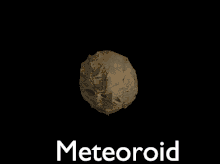

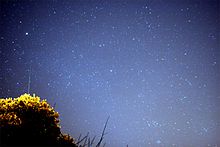


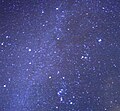









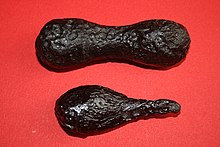





Tidak ada komentar:
Posting Komentar